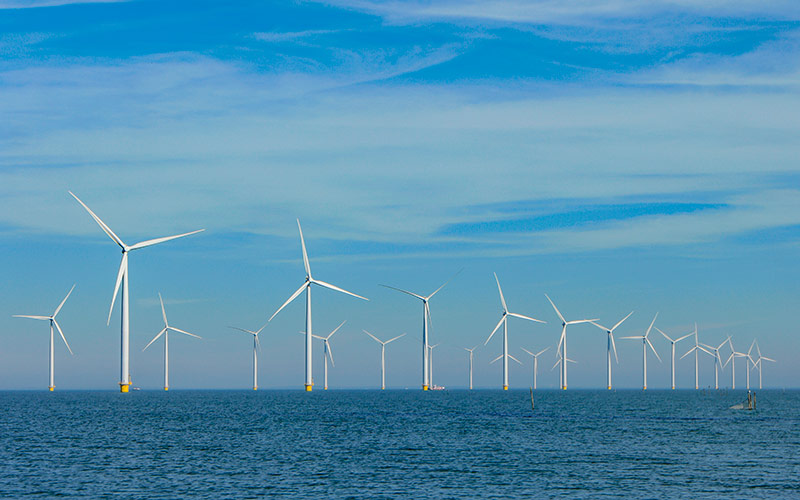
Offshore wind is a cleaner and cheaper form of energy for New England. Photo: Shutterstock.
The recent heat waves that scorched New England with over 95-degree temperatures are a reminder of how much climate change is threatening us right now. And as we swelter in these heat waves, our wallets are hit just as hard with high electricity bills from cooling our homes. We need to upgrade how we power our lives without sacrificing the climate or our finances. Offshore wind can help.
Right now, Connecticut, Massachusetts, and Rhode Island are working together to purchase electricity from offshore wind farms that will power our homes and businesses. The three states have asked energy companies to submit project proposals that would generate nine gigawatts of energy by 2030 – enough to power just over 3,000,000 homes.
A Synapse Energy Economics Inc. study finds that this tri-state offshore wind collaboration will slash bills and pollution. Let’s see how.
Offshore Wind is Cheaper Than Natural Gas
Our region relies heavily on burning imported fossil fuels like natural gas to generate electricity. These fuels are costly – and their prices are rising steadily. As a result, New Englanders pay some of the highest electricity prices in the country.
Gas’s price volatility makes it more expensive. Costs wildly fluctuate, often spiking our bills during times of highest demand or international crises that affect gas supply, like when Russia waged its war on Ukraine.
Offshore wind, on the other hand, is local, price stable, and cheaper than natural gas. According to Synapse, nine gigawatts of wind energy by 2030 would, on average, save New Englanders $630 million on electricity bills annually. It would also keep $1.57 billion within the region’s economy that we would have otherwise lost buying and importing natural gas from other regions or other countries.
Important to note is that the companies chosen to complete this project will pay the upfront costs of development, construction, and connecting the energy to the grid themselves, meaning that electricity customers will not be the ones paying these costs.
So, what does this mean for you? It means cheaper electricity bills every month. And it means more consistency in those bills regardless of season or global politics outside our control.
Offshore Wind is Healthier and Cleaner Than Natural Gas
Burning gas near and within our homes is a hazard. Gas heating and stoves, for example, greatly reduce indoor air quality, triggering or worsening respiratory and cardiac illnesses. Gas is also an extremely explosive fuel. Leaky, outdated pipelines snaking underneath our communities put us all in danger of unpredictable explosions, like those that rocked the Merrimack Valley in 2018.
In addition to emitting toxic air pollution, burning gas to power our homes and businesses damages the climate, fueling extreme weather and temperatures (like the heat wave we just experienced). As long as we stay tied to outdated fossil fuels, we can count on these impacts worsening in severity and frequency.
On the other hand, offshore wind won’t release this toxic pollution – slowing climate change and protecting the people we love. Synapse finds that nine gigawatts of offshore wind by 2030 would cut pollution so much that families would save $362 million every year with fewer hospital and emergency room visits, illnesses, and other public health benefits. Not to mention, the study finds that this tri-state collaboration would cut just under half our electricity sector’s carbon pollution. Offshore wind means a healthier planet and a healthier future for generations to come.
New England Needs to Double Down on Offshore Wind
The collaboration between Connecticut, Massachusetts, and Rhode Island on offshore wind purchases is a great example of how the region can work together for the sake of its residents, our children, and our grandchildren. Synapse’s study shows that offshore wind is a key component in slowing down our rapidly overheating planet while saving us money and protecting our health.
The three states are expected to select the winning projects in early August. Around that time, states will reveal more details, including how much electricity will cost for the contract term. After winning projects are selected, CLF will be involved in the next review process to ensure that these proposed projects remain in the best interest of New England’s families, businesses, environment, and economy. We will be tracking these proposals as they progress, so stay up to date by signing up for our emails.



